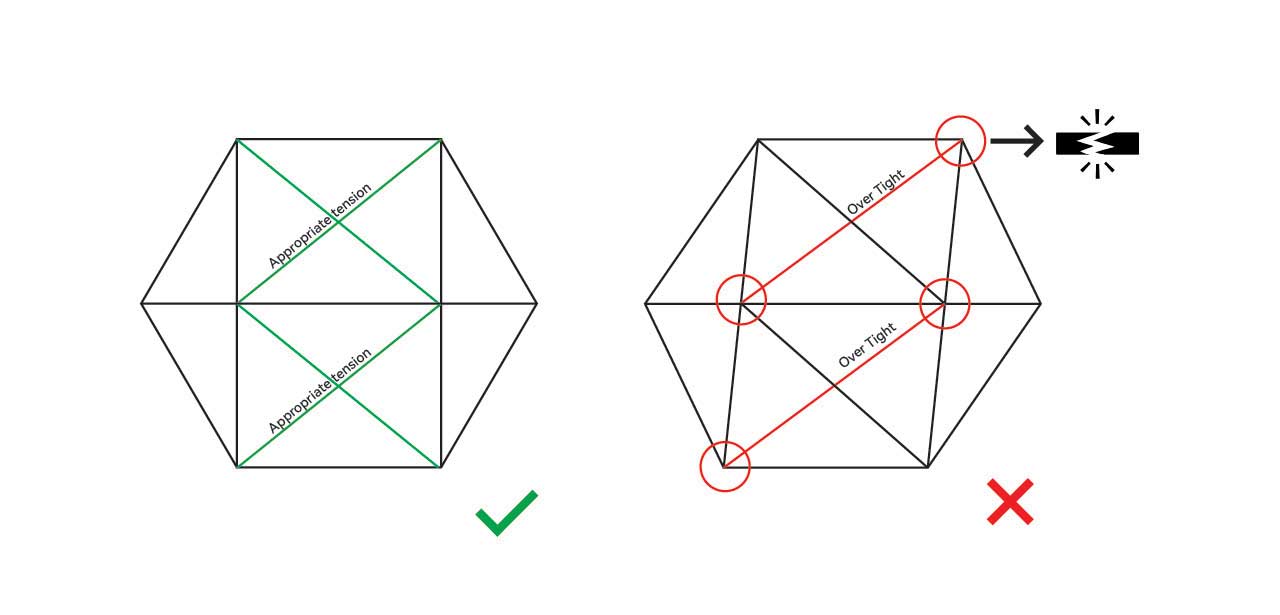

Standard Pitching Method:
- Lay the tent flat on the ground and use a stake to secure one corner of the fly to prevent it from being blown away.
- Stake out the nearest adjacent corner so that the short side of the tent is straightened, but not fully tensioned.
- Unfold the tent—you’ll see it’s shaped like a hexagon, but ignore the vestibules and treat it as a rectangle.
- Locate the opposite short side. Bring the two corners of this short side together, turning the tent into an isosceles triangle. Using this shape, find the midpoint of the short side’s projection on the ground. Align this midpoint with the midpoint of the tent’s base projection.
Use this technique to stake out both ends of the second short side, forming a proper rectangle. Check for any distortion in the shape. If it’s uneven, make necessary adjustments. - Insert trekking poles to support the tent, then stake out the vestibule sides and guy lines.
Beginner Method:
Lanshan 2 tents are designed with positioning cords that you can utilise to pitch your tent, please refer to the following article:
How to pitching your Lanshan tent perfectly – official recommendation
Important Notes:
- The stake cord tensioners at four corner should align as closely as possible with the direction of the side ridgeline. Otherwise, the stake will bear excessive tension and may be pulled out of the ground.
- Do not overtighten the side guylines. Is may break tent’s tension balance and may even cause damage to the tent.
Trouble Shooting:
1. The side ridgeline is sag:
Under normal conditions, a properly pitched tent shouldn’t require over-tightening of the guyline adjusters. When the tent’s base projection forms a perfect rectangle, the structure will naturally become taut even under minimal tension. However, if the base isn’t a standard rectangle, it becomes difficult to get a proper pitch—especially with nylon tents, which are inherently elastic. While it’s possible to force the tent tight with brute strength, doing so can cause irreversible damage. The most common issue is that the needle holes get stretched or torn, compromising the fabric’s integrity.
2. Sag ridgeline between the two peaks:
This issue is usually caused by incorrect setup of the trekking poles or the guy lines on either side of the vestibule. Make sure the trekking poles are positioned vertically (perpendicular to the ground), and that the vestibule guy lines are angled correctly—ideally perpendicular to the long side of the inner tent. This ensures balanced tension across the structure. Of course, if the tent’s base projection isn’t a proper rectangle, this problem may also occur.
3. The peak height can’t reach 125cm:
Even after setting your trekking pole to 125cm, sometimes you might find it too tall to stand vertically and support the tent properly. This usually happens when the two short sides of the tent are staked too far apart. Try repositioning one of the short-side stakes to reduce the distance between the two short sides by 5–10 cm. If the pole still won’t fit vertically, shorten the distance by another 5–10 cm and try again.

If the inner tent floor isn’t properly set up as a rectangle and ends up forming a diamond shape instead, forcefully tightening the tent can cause uneven tension on the fabric. This may lead to damage or even tearing of the tent material.
